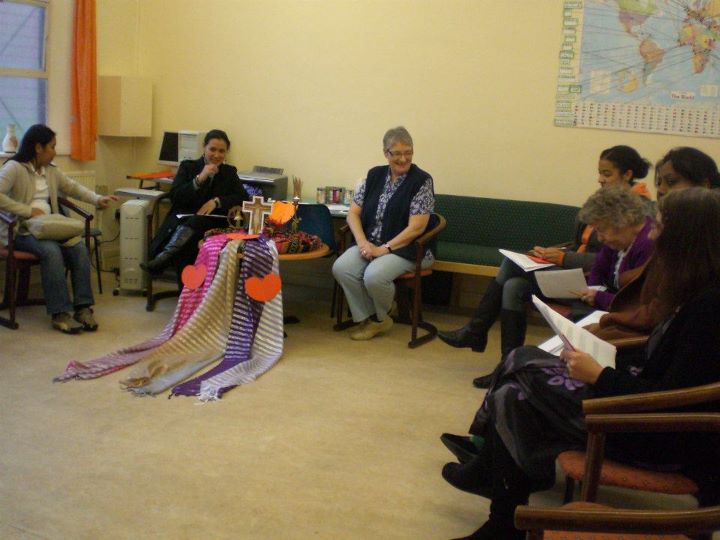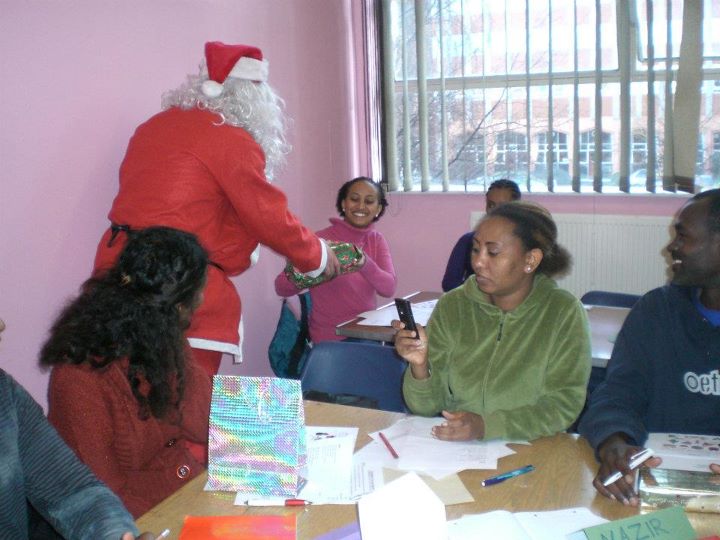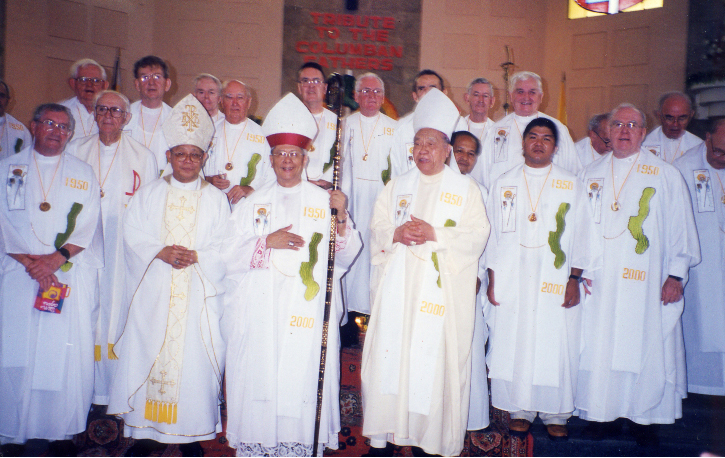Misyon Online - January-February 2012
Pulong ng Editor

Who Are the Columbans?
By Jack Pamine
Jack Pamine, originally from Bohol, lives in Bacolod City and worked with the Columbans from 1993 until 2010. Here he writes about Columban priests he has known and worked with.
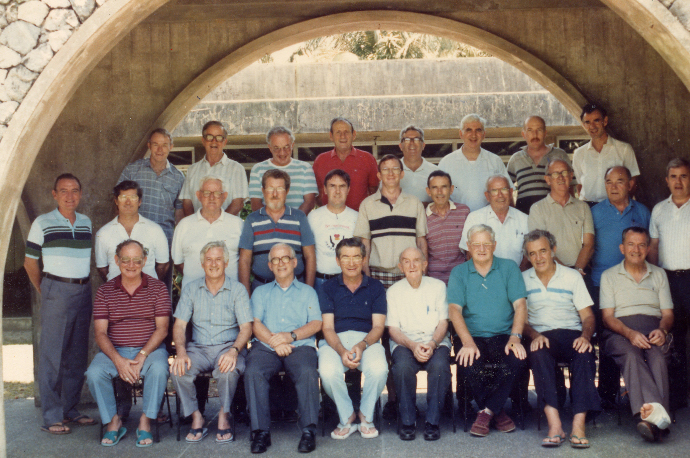 Who are the Columbans? That was the lingering question I had. Later, I understood that it is hard to find the collective identity of the group but that its strength is found in each member's spirituality and charism. How each tries to live his missionary life is really amazing. What you find is individual Columbans, each trying to live his vocation to the fullest. The Society of St Columban is not meant to be a religious community but a group of priests committed to working overseas on mission, building up the local Church.
Who are the Columbans? That was the lingering question I had. Later, I understood that it is hard to find the collective identity of the group but that its strength is found in each member's spirituality and charism. How each tries to live his missionary life is really amazing. What you find is individual Columbans, each trying to live his vocation to the fullest. The Society of St Columban is not meant to be a religious community but a group of priests committed to working overseas on mission, building up the local Church.


We too were asylum seekers
By Gertrudes Samson
‘Ger’ Samson, from Balintawak, Quezon City, is an architect by profession and went to England as a Columban Lay Missionary in 2010. Here she writes about her experience with asylum seekers in Birmingham.
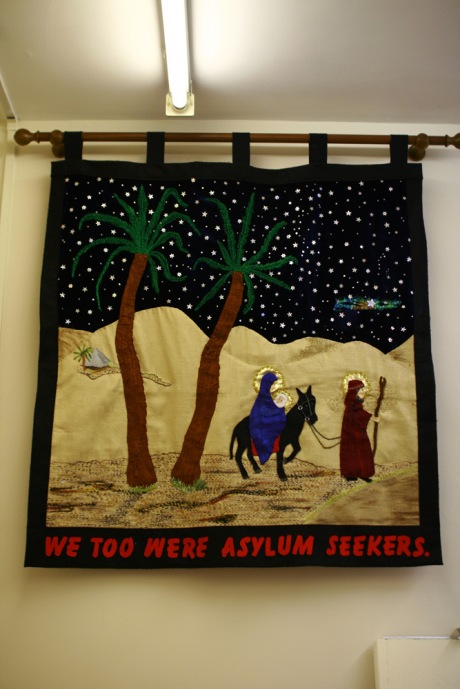
When I first entered St Chad’s Sanctuary, a voluntary project of St Chad’s Catholic Cathedral, Birmingham, and the Salvation Army, I noticed at once the beautiful tapestry hanging at the right side of its main hall. It depicts the Holy Family on a journey with Mother Mary riding on a donkey while carrying baby Jesus and with St Joseph walking beside them. I thought it was just a typical Christmas decoration, but the caption at the bottom read: ‘WE TOO WERE ASYLUM SEEKERS’.

What Gets You Up in the Morning?
A vocation story interview with Fr Oliver McCrossan
1. How did you become a priest? We want to know where you started.
I was born in Ireland, in County Donegal. We are five in the family. My background is Catholic. When I was growing up in the 1960s there wasn’t enough opportunities for other work so I got interested in the Columbans. For some reason I wanted to be a missionary, not a diocesan priest because basically I was interested at that time in the Third World and I read in the Far East magazine, which we got at home, about what Columban missionaries were doing. So I was inspired by them. I wanted to go abroad and help others. I suppose it comes from my family, my mother and father were kind people. They were ordinary people, working people who struggled for life. We lived in a small rural community so I know what people have to go through. That’s the reason why I have always been interested in helping people. So I decided to join the Columbans.

With Shepherds in Uganda
By Leo P. Divinagracia
Leo P. Divinagracia is a former Mill Hill Missionary seminarian. Here he shares his mission experience in Karamoja, Uganda, a very dry place where sometimes there is no rain for almost the entire year. At Present he is an AMA Volunteer (Associate Missionaries of the Assumption) assigned in Kauswagan, Lanao del Norte as a CLE teacher in St. Vincent’s Academy. His students were both Christians and Muslims. A parish run by the Columban Missionaries for a number of years.
After two years of theological studies in Tangaza College, Nairobi, Kenya, I came home for a two-month break. When I was in Kenya, there were times I felt like going home. But when I arrived home, I felt like going back to Africa right away.

A Life Well Lived
Beth Sabado is a Columban Lay Missionary from Pagadian City. A registered nurse, she is based in Taiwan where she works at the Hope Workers’ Center.
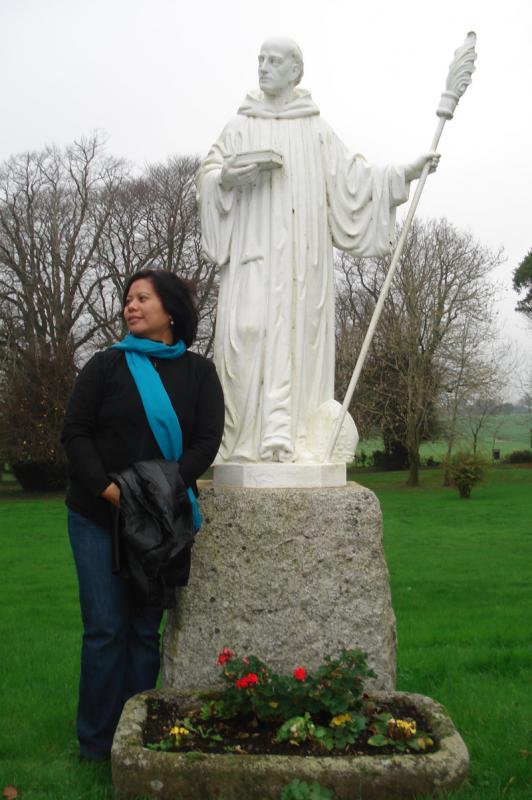 One of the highlights of my stay in Pagadian during my home vacation in the Philippines was the regular gatherings I had with my high school batch-mates. I definitely consider this group to be my second family because of the friendship that we’ve established through the years. With them, I feel comfortable enough to share both the easy and tough times, and just be myself. One day, we agreed to visit a classmate. I was so excited to meet him after 26 years. But just before the visit, some of our batch mates who regularly visit Jovito said, ‘His situation is really unfortunate. You might cry in front of him. Heaven forbid, don’t’.
One of the highlights of my stay in Pagadian during my home vacation in the Philippines was the regular gatherings I had with my high school batch-mates. I definitely consider this group to be my second family because of the friendship that we’ve established through the years. With them, I feel comfortable enough to share both the easy and tough times, and just be myself. One day, we agreed to visit a classmate. I was so excited to meet him after 26 years. But just before the visit, some of our batch mates who regularly visit Jovito said, ‘His situation is really unfortunate. You might cry in front of him. Heaven forbid, don’t’.
Most of us have significant dates we remember. For priests and those in religious life religious it would be the dates of their ordination and final vows, for most people their birthdates, for married couple their anniversaries, and so on. These dates are well remembered and observed mostly with a special meal or a celebration. But there are also those who remember significant dates because of a misfortune, a disaster, a loss. Either way, one event in one’s life can mark a new beginning, a new unfolding, a change.

Pulong ng Editor
A Life Well Lived
By Beth Sabado
Beth Sabado is a Columban Lay Missionary from Pagadian City. A registered nurse, she is based in Taiwan where she works at the Hope Workers’ Center.
 One of the highlights of my stay in Pagadian during my home vacation in the Philippines was the regular gatherings I had with my high school batch-mates. I definitely consider this group to be my second family because of the friendship that we’ve established through the years. With them, I feel comfortable enough to share both the easy and tough times, and just be myself. One day, we agreed to visit a classmate. I was so excited to meet him after 26 years. But just before the visit, some of our batch mates who regularly visit Jovito said, ‘His situation is really unfortunate. You might cry in front of him. Heaven forbid, don’t’.
One of the highlights of my stay in Pagadian during my home vacation in the Philippines was the regular gatherings I had with my high school batch-mates. I definitely consider this group to be my second family because of the friendship that we’ve established through the years. With them, I feel comfortable enough to share both the easy and tough times, and just be myself. One day, we agreed to visit a classmate. I was so excited to meet him after 26 years. But just before the visit, some of our batch mates who regularly visit Jovito said, ‘His situation is really unfortunate. You might cry in front of him. Heaven forbid, don’t’.
Most of us have significant dates we remember. For priests and those in religious life religious it would be the dates of their ordination and final vows, for most people their birthdates, for married couple their anniversaries, and so on. These dates are well remembered and observed mostly with a special meal or a celebration. But there are also those who remember significant dates because of a misfortune, a disaster, a loss. Either way, one event in one’s life can mark a new beginning, a new unfolding, a change.

Beth (at the center) with her high school batchmates
A significant date for Jovito Ubanan, a high school classmate who used to be known as one of the tallest and gentlest persons in the class, is 4 January 1989. He was a famous student known for his patience and art works. It was on this day that he was able to stand up and walk for the last time. Who would have imagined that at the age of 20, the dreams and hopes of this college graduating young man would crash down with him when he fell on the ground? Jovito’s world collapsed.
This horrible incident happened while he was visiting an uncle. Jovito and his Dad went out to buy something when all of a sudden he was down on the ground, bleeding. He can still recall the commotion that occurred after he was gunned down by an unknown assailant who quickly got away. He was shot with a .38 caliber gun injuring his spinal column and causing an irreversible paralysis in his lower extremities. Jovito is now 42 and has been confined to bed for 22 years. He cannot think of any reason for being shot and believes it was a case of mistaken identity.
The day we visited Jovito, he was lying in bed. He still looked the same, his skin was fair,his hair neatly combed, he was smiling, laughing, and greeting us by name. He reached out his arms and hugged each one of us. He said, ‘You all look older, I missed all of you’. When I saw him, I was struck with what I saw and struggled not to cry. I saw near his bed a table, a rice cooker, bottled water. By the wall over the headboard was a tiny mirror, a small sliding window, some books. A Bible was placed on an improvised bookshelf just above the window. Different electrical switches, a sound system, and an altar were on the right side of the wall. An innovative electric charcoal fan that he designed was located near his foot. And, all around, the room was filled with his artworks. My sighs were covered by the laughter of our friends and the exchange of stories of our years in high school; how some of us escaped, cut classes, tricked our teachers, how some classmates copied the wrong and right answers and how others knelt and prayed the rosary, especially after being caught late for the flag ceremony. It was a precious time for us recalling all our carefree moments in high school.
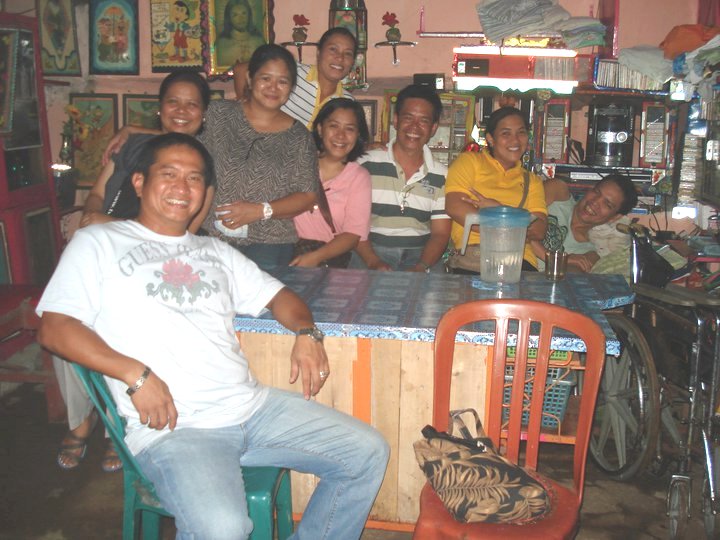
Jovito at the rightmost lying on his bed
After our bouts of laughter ended, a deafening silence followed. To break it, I took the courage to ask how he had been. His reply was short and simple, ‘Life must go on’. I was amazed at how he spontaneously answered my question; his eyes expressed a genuine peace. Before we left, the group gathered in prayer then took some photos as a remembrance of that sacred and memorable afternoon. After a few days, I returned to Jovito’s place to bring him copies of the pictures and to ask his permission if I could write this article about him. With all humility, he said yes.
What deeply amazed me was that, despite his condition, Jovito is living on his own, independent of his family. Both his parents are aging, and are taken care of by one of his siblings. His other siblings have their own families. He earns a living by managing a welding shop that was established for him by his father. He has three full-time workers. His physical condition does not hinder him from living his life to the fullest. Seeing him in this condition was overwhelming yet inspiring. This man who is physically challenged is far more productive compared to a completely able-bodied person who easily takes his God-given strength for granted and not use it.
Jovito cannot walk nor stand anymore, yet his inner strength makes him one of the strongest men I know. Despite going through a lot of turmoil in his life, he has the courage and determination to face life head on. He was crushed to the ground, but his strong heart allowed him to soar high above his circumstances. Jovito has grieved the loss of the life he couldn’t have when he lost control of parts of his body, but he is determined not to let it engulf him. There have been times when, like one of Jesus’ apostles, Thomas, Jovito doubted and questioned God. But even with all the uncertainties, he clings to his faith and hope in God. He has forgiven the man who shot him and having done so feels free within himself. He is at peace with his past and how it has changed him.
You may email Beth Sabado at bethsablm@yahoo.com
OUTDOOR MASTER, INC.
Revitalizing the Church: Bringing the Gospel to the Deaf
By Erl Dylan J. Tabaco
The author is a Columban seminarian from Cagayan de Oro City.
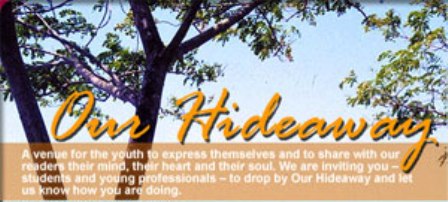
I grew up in Holy Rosary Parish, Agusan, Cagayan de Oro City, where church organizations flourished at the time I got involved in parish activities. As early as high school, I was already working in the parish and I was really amazed by the parishioners’ dedication in serving the Church. Among the organizations, Ministry to the Deaf caught my attention and I was motivated to work with it. I remember one time at Mass there was a Sign Language interpreter. I told myself that someday I would be standing there in front ministering to the Deaf, bringing the Good News to them. With my desire to be part of the Ministry to the Deaf, I studied Sign Language for two months and worked with the Deaf community for a year.
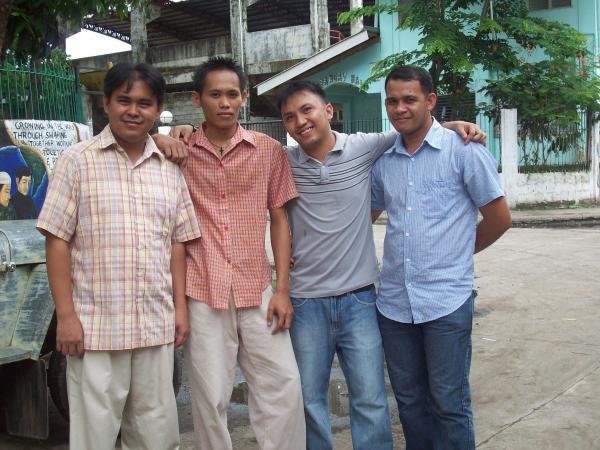
Erl, second from right, with fellow youth leaders in Holy Rosary Parish
Working with the Deaf entails challenges and sometimes frustration, especially when it is difficult to communicate with them. However, that year of experience made me feel more at home with the Deaf. Seeing them begin to express themselves to me more freely made me happy and at the same time sad, especially when they shared the problems and struggles they had been through. As they shared their life stories, I was moved to pity and it really broke my heart. Despite the adversities that they’ve been through, they still consider themselves blessed to have a community where they can relate to or build relationships with people who have dedicated their lives to service.
One experience I won’t forget was the sharing that we had about a particular Sunday gospel. As I interpreted the reading, I also encouraged the Deaf to share something about it and reflect on how the Word of God touched them by looking at it through their own personal experiences. They were so vibrant and attentive during the sharing. One of them, a single mother, shared that life for her was very difficult. She raised her only child by doing laundry because that was the only work that she could do, considering her situation. In spite of the challenges, she didn’t lose hope. That was what struck me most. She may not have been equipped with all the knowledge a theologian can have, but one thing was sure: she was a firm believer in God who continued to look after her, who continued to give her strength and courage to move on. Her daughter was an inspiration to her. She wanted to give her a good education.
Reflecting on this, I realized that despite their speaking and hearing disability, there are so many things that we can learn from the Deaf. I gained their trust and especially their passion to know many things about God. It was so inspiring to see their dedication in attending Sunday Mass and participating in parochial activities. Most of the Deaf I ministered to belonged to poor families and so many were deprived of social services such as education. Despite their situation, they continue to strive to live a normal life. They go to church, blend with the people outside but are often neglected or marginalized.
In the seven years since I first got involved with the Deaf, I’ve realized that speech impediments or physical disabilities hinder persons neither from expressing their faith or living in a community. It just takes one or two persons with dedication and love for the Deaf to enable them to build their confidence and self-worth. At first they may be aloof but once you show your compassion and sincerity to them, they will treasure you and make you their confidant. On the other hand, if you lose their trust, it is very difficult to rebuild it.
This inspired me to give more of myself as an individual called to serve those who need special treatment, such as the Deaf. When I entered the seminary, I thought it was the end of my connection with the Deaf. To my surprise, I was even more exposed to opportunities to serve them. I’ve been to different parishes in Manila where there is Deaf Ministry. I am very happy seeing them as they commit themselves in the ministry. I also had an opportunity to interpret the liturgy for them and it was a grace-filled moment for me in bringing the gospel message to them.
Recently I have been handling catechetical sessions every fourth Sunday of the month with the Deaf under the care of the Daughters of St Anne as part of my extended apostolate. I assist them in their journey towards knowing God. These are brothers and sisters prone to exploitation, deception and all sorts of injustice. I am happy to see them expressing themselves gradually, whether inside or outside the church. I find fulfillment as I work with them. I believe deep in my heart that this is one of my missions in life. This is where I find my happiness. In my own little way I want to make a difference to their lives. I hope that more churches or parishes will offer programs for the Deaf and that through these our brothers and sisters who have hearing and speaking disabilities may continue to feel God’s compassion for them.
You may email the author at earl.dylan@yahoo.com
Peace By Peace
EDUCATING YOUNG PEOPLE IN JUSTICE AND PEACE
Here is one paragraph from the Pope’s message.
 Only in relation to God does man come to understand also the meaning of human freedom. It is the task of education to form people in authentic freedom. This is not the absence of constraint or the supremacy of free will, it is not the absolutism of the self. When man believes himself to be absolute, to depend on nothing and no one, to be able to do anything he wants, he ends up contradicting the truth of his own being and forfeiting his freedom. On the contrary, man is a relational being, who lives in relationship with others and especially with God. Authentic freedom can never be attained independently of God.
Only in relation to God does man come to understand also the meaning of human freedom. It is the task of education to form people in authentic freedom. This is not the absence of constraint or the supremacy of free will, it is not the absolutism of the self. When man believes himself to be absolute, to depend on nothing and no one, to be able to do anything he wants, he ends up contradicting the truth of his own being and forfeiting his freedom. On the contrary, man is a relational being, who lives in relationship with others and especially with God. Authentic freedom can never be attained independently of God.
Full Message here.
 I would like the angels of Heaven to be among us. I would like an abundance of peace. I would like full vessels of charity. I would like rich treasures of mercy. I would like cheerfulness to preside over all. I would like Jesus to be present. I would like the three Marys of illustrious renown to be with us. I would like the friends of Heaven to be gathered around us from all parts. I would like myself to be a rent-payer to the Lord; that I should suffer distress, that he would bestow a good blessing upon me. I would like a great lake of beer for the King of Kings. I would like to be watching Heaven's family drinking it through all eternity.
I would like the angels of Heaven to be among us. I would like an abundance of peace. I would like full vessels of charity. I would like rich treasures of mercy. I would like cheerfulness to preside over all. I would like Jesus to be present. I would like the three Marys of illustrious renown to be with us. I would like the friends of Heaven to be gathered around us from all parts. I would like myself to be a rent-payer to the Lord; that I should suffer distress, that he would bestow a good blessing upon me. I would like a great lake of beer for the King of Kings. I would like to be watching Heaven's family drinking it through all eternity.
St Brigid of Ireland, Abbess of Kildare (c. 450 – 525). Feast Day, 1 February.
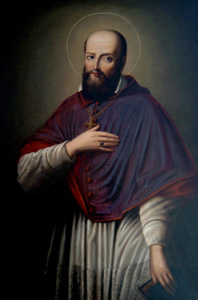
Never be in a hurry; do everything quietly and in a calm spirit. Do not lose your inner peace for anything whatsoever, even if your whole world seems upset.
St Francis de Sales, Bishop of Geneva, Doctor of the Church (1567 – 1622). Feast Day, 24 January. He is the patron saint of writers, journalists and of the Deaf.
 Wars against nations are fought to change maps; wars against poverty are fought to map change.
Wars against nations are fought to change maps; wars against poverty are fought to map change.
Muhammad Ali (born 17 January 1942)
 We have disobeyed the law of love. Joyfully we have hated one another; joyfully we have killed one another. And now at last we have brought this great and evil war to an end. But in order to restore peace to the world it was not sufficient to repent. We had to obtain God's pardon through the offering of a great sacrifice...
We have disobeyed the law of love. Joyfully we have hated one another; joyfully we have killed one another. And now at last we have brought this great and evil war to an end. But in order to restore peace to the world it was not sufficient to repent. We had to obtain God's pardon through the offering of a great sacrifice...
Dr Takashi Nagai, Mystic of Nagasaki (1908 – 1951)
 When Takashi Nagai became a Catholic in 1934 he took ‘Paul’ as his Christian name. He met St MazimilianKolbe OFM Conv, then a missionary in Japan, who died a martyr in Auschwitz on 14 August 1941. Nyodo-dō Hermitage, Nagasaki, built for Takashi Nagai after World War II. ‘Nyodo-dō’ is derived from the words of Jesus, ‘Love your neighbor as yourself’.
When Takashi Nagai became a Catholic in 1934 he took ‘Paul’ as his Christian name. He met St MazimilianKolbe OFM Conv, then a missionary in Japan, who died a martyr in Auschwitz on 14 August 1941. Nyodo-dō Hermitage, Nagasaki, built for Takashi Nagai after World War II. ‘Nyodo-dō’ is derived from the words of Jesus, ‘Love your neighbor as yourself’.
 We are talking only to ourselves. We are not talking to the rivers, we are not listening to the wind and stars. We have broken the great conversation. By breaking that conversation we have shattered the universe. All the disasters that are happening now are a consequence of that spiritual ‘autism.’
We are talking only to ourselves. We are not talking to the rivers, we are not listening to the wind and stars. We have broken the great conversation. By breaking that conversation we have shattered the universe. All the disasters that are happening now are a consequence of that spiritual ‘autism.’
Fr Thomas Berry CP, American Eco-theologian (1914-2009)
Suffering Is Not Enough (An Excerpt)
by Thích Nhất Hạnh
(A Buddhist monk born in Vietnam in 1926, now based in France)
Life is filled with suffering, but it is also filled with many wonders, like the blue sky, the sunshine, the eyes of a baby. To suffer is not enough. We must also be in touch with the wonders of life. They are within us and all around us, everywhere, any time.
If we are not happy, if we are not peaceful, we cannot share peace and happiness with others, even those we love, those who live under the same roof. If we are happy, if we are peaceful, we can smile and blossom like a flower, and everyone in our family, our entire society, will benefit from our peace. Do we need to make a special effort to enjoy the beauty of the blue sky? Do we have to practice to be able to enjoy it? No, we just enjoy it. Each second, each minute of our lives can be like this. Wherever we are, any time, we have the capacity to enjoy the sunshine, the presence of each other, even the sensation of our breathing. We don't need to go to China to enjoy the blue sky. We don't have to travel into the future to enjoy our breathing. We can be in touch with these things right now. It would be a pity if we are only aware of suffering.
Peace I leave with you; my peace I give to you; not as the world gives do I give to you. Let not your hearts be troubled, neither let them be afraid (John 14:27).
To Search is To Find

The Feast of the Sto Niño is observed in the Philippines on the Second Sunday in Ordinary Time, which falls this year on 15 January. Some time ago we received a question at forum@misyononline.com about the different kinds of statues of the Sto Niño and responded in our Forum. Here are the question and answer, slightly edited.
Hi. I am from Singapore and recently I've started the devotion to Santo Niño after I brought back a Santo Niño from Tacloban. The Holy Child is wearing a hat, carries a bag on his left hand, which is raised in blessing, and on his right hand, he carries a cross. He is dressed in green.
Below are the questions I have:
- I would like to know the name of this particular Santo Niño and its historical and cultural background.
- It seems that there are so many types of Santo Niño in the Philippines. Why is that so?
- I would also like to know how I can express my devotion to this particular Santo Niño which I brought back from Tacloban.
- How many Santo Niños can I place in my house? Can I have a collection of different Santo Niños on one altar? Will there be a conflict?
- What is the difference between a Santo Niño dressed in green and one in red? Do I need to have both on my altar only one?
Since the earliest days of Christianity artists have been depicting Jesus as a child, during his public life, on the Cross, after his Resurrection. There are no photos of Jesus so artists use their imagination.
In art galleries you will find different paintings and statues of Jesus. There is no reason why an individual cannot build a collection of artistic depictions of Jesus. So if you want to collect different versions of the Sto Niño there is nothing wrong with that.
When a devotion spreads, local artists often make a new statue or painting and this is probably the reason for the variations to be found in the Philippines and elsewhere.
I would suggest that from a devotional point of view you use only one on your altar at home, preferably an image of the Sto Niño de Cebu. There is no reason why you cannot place other versions around your house.
Devotion to the Child Jesus is not only a Filipino thing. In the home of your editor in Dublin we had an image of the Child of Prague, as did many other homes. You can read about it here. That page has a link to one about the Sto Niño de Cebu.
I will give you links to some articles on the Sto Niño that you may find helpful. One is to an entry on my personal blog, The Sleeping Santo Niño.
Here is an item in our forum from last year, Feast of Santo Niño, with links to other articles on the topic. (The links may not all work).
You can read about the Basilica Minore del Santo Niño here. The official website isn’t functioning at this time.
There is a discussion about the different colors here. I’m not sure what authority the views expressed carry. However, like the first to comment on that page I think that any idea of good luck, etc, is a distortion of proper devotion to the Child Jesus.
I hope that this helps. God bless you.
We too were asylum seekers
By Gertrudes Samson
‘Ger’ Samson, from Balintawak, Quezon City, is an architect by profession and went to England as a Columban Lay Missionary in 2010. Here she writes about her experience with asylum seekers in Birmingham.
 When I first entered St Chad’s Sanctuary, a voluntary project of St Chad’s Catholic Cathedral, Birmingham, and the Salvation Army, I noticed at once the beautiful tapestry hanging at the right side of its main hall. It depicts the Holy Family on a journey with Mother Mary riding on a donkey while carrying baby Jesus and with St Joseph walking beside them. I thought it was just a typical Christmas decoration, but the caption at the bottom read: ‘WE TOO WERE ASYLUM SEEKERS’. It depicts the Holy Family on their flight to Egypt from the persecution of Herod who wanted to kill baby Jesus. That tapestry explained to me in a nutshell what St Chad’s Sanctuary is about and the value of its work.
When I first entered St Chad’s Sanctuary, a voluntary project of St Chad’s Catholic Cathedral, Birmingham, and the Salvation Army, I noticed at once the beautiful tapestry hanging at the right side of its main hall. It depicts the Holy Family on a journey with Mother Mary riding on a donkey while carrying baby Jesus and with St Joseph walking beside them. I thought it was just a typical Christmas decoration, but the caption at the bottom read: ‘WE TOO WERE ASYLUM SEEKERS’. It depicts the Holy Family on their flight to Egypt from the persecution of Herod who wanted to kill baby Jesus. That tapestry explained to me in a nutshell what St Chad’s Sanctuary is about and the value of its work.
Asylum seekers are persons fleeing persecution in their homeland, have arrived in another country, made themselves known to the authorities, and exercised the legal right to apply for asylum. St Chad’s Sanctuary ministers to them and to others who are far from home. It offers friendship and hospitality to asylum seekers, refugees, and other migrants. We try to give them listening, non-judgmental and compassionate hearts that respect human dignity irrespective of culture, faith, or background of the person. The sanctuary is operated by one full-time manager, Sr Margaret Walsh IJS, and part-time volunteers like me.
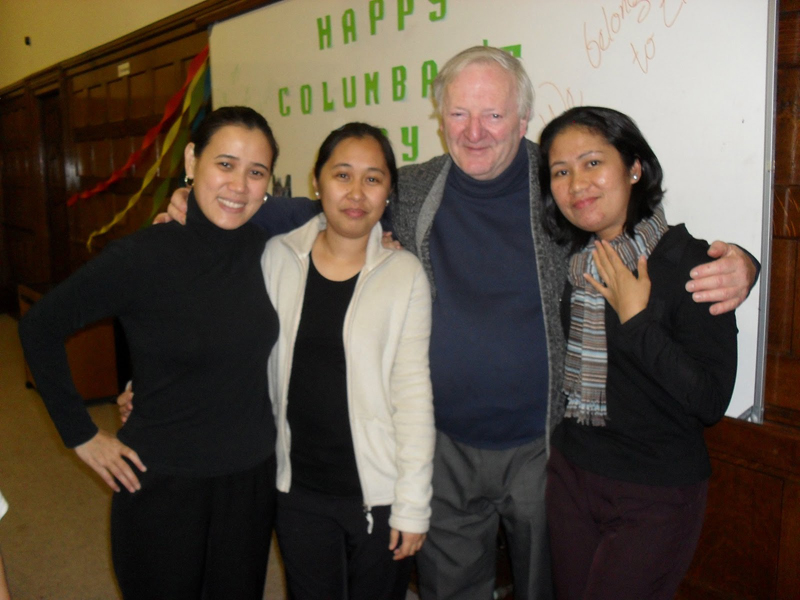
Gertrudes Samson (L) with co-workers Jayjay, Rose, and Fr Patrick Sayles
You might ask what else we do at the Sanctuary aside from listening to and talking with people. Actually we have many works. The following are only some of the opportunities I get to help out with in various ways with other volunteers:
- sitting down with the asylum seekers in English classes to help them catch up with the lessons given by the teacher, especially during the drills or exercises;
- one on one tutoring with those who don’t even know the basics of English, ie, Pre-Entry Level, because they would have a hard time catching up if placed at once in Level 1, the ‘Survival English’ class; we start with such basic things as the Roman alphabet and reading the clock;
- preparing and offering coffee or tea and biscuits (cookies) for those who come to the Sanctuary;
- washing dishes;
- sorting and organizing many piles of donated clothes to ensure they are clean and still useful and not rags;
- sorting and repacking donated foods and ensuring that they have not yet reached their ‘sell-by’ date;
- distributing donated food bags, clothes, and household items to asylum seekers;
- recording data and statistics about the work of the Sanctuary,
- cleaning up the Sanctuary work areas and premises.
Honestly speaking, at the end of every day I feel very tired because there is so much work to do in the Sanctuary because volunteers are so few. But definitely, I am happy! – for the many people I have met from more than 80 different nationalities; for the loving friends I have gained in the persons of Sr Margaret, other volunteers, and asylum seekers; but most of all, because of the opportunity God has given me to serve Him there . . . for Jesus said, ‘I tell you whatever you did for one of the least of these brothers and sisters of mine, you did for me’. Although I was not born at the time when Jesus and His family were still asylum seekers, I know I am serving Him at the Sanctuary in the person of every asylum seeker I meet. With that in my heart, I know . . . Jesus is happy with us too in St Chad’s Sanctuary – my place of ministry.
You may email the author at ger_samson@yahoo.com
What Gets You Up In The Morning?
A vocation story interview with Fr Oliver McCrossan
1. How did you become a priest? We want to know where you started.
I was born in Ireland, in County Donegal. We are five in the family. My background is Catholic. When I was growing up in the 1960s there wasn’t enough opportunities for other work so I got interested in the Columbans. For some reason I wanted to be a missionary, not a diocesan priest because basically I was interested at that time in the Third World and I read in the Far East magazine, which we got at home, about what Columban missionaries were doing. So I was inspired by them. I wanted to go abroad and help others. I suppose it comes from my family, my mother and father were kind people. They were ordinary people, working people who struggled for life. We lived in a small rural community so I know what people have to go through. That’s the reason why I have always been interested in helping people. So I decided to join the Columbans.
2. How old were you when you joined the Columbans?
I was 18. I was ordained in 1975. There was a lot of turmoil then at the time of Vatican II. So many changes in the seminaries, the Church was opening up to the world, and opening up to new ideas. So I wanted to go abroad and was very happy to come to the Philippines. I was sent to Ozamiz in 1976 to study Cebuano but my assignments were in mostly in Pagadian Diocese.
3. How was it for you, when you first came here?
How can you prepare for another language and culture? It’s difficult. The language was very difficult at the beginning, strange food. But the priests who were here before me were experienced and gave me good advice. I wasn’t coming here as a stranger so that helped. My first parish priest in Pagadian was the late Fr Des Hartford. I had a very good experience with the priests.
4. Since you came here, you were never away?
I was away from 1997 until 2002 in Ireland, doing studies. I’m going away now in July [2011] for a sabbatical. I feel the need to have a break from here, visit my family and take time out. I’ve spent 30 years more of my life here and I’ve enjoyed my work. I’m very happy here.
5. Tell us your vocation story.
The gospel means something to me and helping the downtrodden. That is my experience here with the people. The Church here in Mindanao has been very involved with the people. I’ve been involved in small Christian communities, justice and peace, human rights advocacies here. There were many who suffered greatly because of the terrible times under Martial Law. I believe that the Church is tasked to be a Church that stands in solidarity with the poor and the oppressed. I’m scared about things like religion or devotion if it’s not contextualized in the suffering of people, if it’s just prayer without connecting with people. It should evolve in communities, like the stories you get from missionaries. I admire people who are working for and with the oppressed and the downtrodden, that kind of commitment.
My vocation, your vocation, our vocation, it’s the same in some ways. The moment that we’re baptized, we belong to the Church, and we try to live out the commitment as best we can. Your commitment, your work in your office is helping spread the gospel by spreading stories of hope. I always like to ask this question: What gets you up in the morning? Why am I here? Why are you here? Why are we here? What keeps you living? Who do you live for? What do you live for? Your family? Your friends? Your work? What kind of commitment?
For me, when you’re helping others, that’s when you get salvation in life. It’s life-giving. It’s not just about concerns with your own little needs but the needs of others. I see these fathers, these pedicab drivers trying to do their best to provide for their children. These people around me, they are the ones who get me up in the morning.
6. In your 30 years here as a missionary priest, was there someone, a young boy maybe who approached you and said ‘I want to become a priest like you’?
Sure, many people have come to me. We didn’t promote ourselves before. We were late in deciding that. We sent interested young men to become priests in their diocese. I’m happy to say that in Ozamiz and especially in Pagadian, some in our youth groups have become priests.
7. The Columbans are getting old, some going back to their home countries to retire. A lot of you have spent more than half of your lifetime here in Philippines doing projects, mobilizing people. Columbans have been our way of life. What happens if you’re all gone?
As for me and my commitment with Pedalling to Live, the reality is that it wouldn’t have started without outside help and funding from overseas that I was able to access through personal contacts and through writing up stories. That started it and we’re trying to be more self-sufficient so the reflow of the money we used for housing.
The Cooperative and the people in it have been doing very well. They have a very good track record so it’s in good hands and I feel I can leave it. It’s not about me, it’s about these people involved in the work. We cannot determine the future, we have to let it go. The Columbans are gone here, everything dies, and things move on, everybody passes off. It’s not forever. The Columbans have left a good memory here generally. We give thanks for that, we think of all the works here, the little projects there, here and all over Mindanao. Even if we are very small we still have an active role.
8. That’s what we quoted you for recently, you used the word ‘tapestry’ in describing the works of the Columbans.
You know, it’s a small drop in the ocean. But every drop counts. That’s what inspires me, that’s what inspired my commitment. I’m grateful for the people I’ve worked with until now. They are the people who have the faith. They have vocation. Those are the people who continue to struggle as they live. As priests, as missionaries, we move and move and move. It’s the ordinary people who are living out the Church’s message more than the priests. I have to go down there and visit and meet the ordinary people, their homes and see their shocking conditions, otherwise I become out of touch. There is a need for a pastoral commitment. And everybody needs it. You also need to be involved, that’s the reason why you have to come here and see people, meet them.
9. In all these things in your missionary life, what image of Christ can you relate yourself to?
He was in Nazareth speaking about serving the poor. And he forgave sinners. He always was forgiving sinners and he went and visited the houses of the so-called sinners and the downtrodden. I’m touched by that message, that commitment. You know the Beatitudes, blessed are the poor in spirit? I’m touched by those things. The life that he lived. That’s what inspires us. He gave his life for others. That’s the essence, that’s the central message. So how do we follow that? We carry our cross. That would be my particular emphasis. What’s the point of speaking if you’re not doing it to action? Our words are useless if we’re not actually involved. We preach the gospel but even more so we live it. And that’s the challenge.
10. In one sentence, what can you tell me about priesthood, something that I could tell my 5-year-old son right now?
Living life to the full. To be a priest is not a lesser life. It means to bloom where you are, use your talents and your gifts, for others. That would be my particular emphasis.
Who Are The Columbans?
By Jack Pamine
Jack Pamine, originally from Bohol, lives in Bacolod City and worked with the Columbans from 1993 until 2010. Here he writes about Columban priests he has known and worked with.
Who are the Columbans? That was the lingering question I had. Later, I understood that it is hard to find the collective identity of the group but that its strength is found in each member's spirituality and charism. How each tries to live his missionary life is really amazing. What you find is individual Columbans, each trying to live his vocation to the fullest. The Society of St Columban is not meant to be a religious community but a group of priests committed to working overseas on mission, building up the local Church.
To work for and with the Columbans wasn’t an easy journey because of the strong individuality of each one. But I found them life-affirming of the uniqueness of each person. In the early part of my work, I found it absurd to wake up at midnight to make a long bus trip, spend less than an hour with a family and run back to the terminal to catch the last bus back to Bacolod.
Even in bad weather, I really had to travel because I’d already arranged a schedule in schools. Sometimes I had to travel by sea, which I’m afraid of because I can’t swim. I was thinking back then of working for the security my family, but the challenge of seeing and working with Columbans with their individual gifts and the thought of participating in their mission was simply energizing.
Traveling and meeting new people in schools kept me going. After a year, Fr Terence Bennett, who had hired me to work with him in the vocations ministry, left me alone when he became a parish priest. He gave me some office space but I decided to transfer to the late Fr Niall O'Brien's place where he edited Misyon. I was happy he accepted me. I had a small table and a computer. With Fr Bennett I had used a typewriter but Fr O'Brien insisted I use a computer and made sure I got one.
I found the Columbans interesting because when you meet people, they never talk about the Society of St Columban but about the individual priests. Their presence was still felt strongly in the 1990s in southern Negros Occidental where they had been working since 1950, Catholic school principals had been hired by Columbans and their stories were very encouraging. That kept me going as well.
I learned so much from most of the Columbans I met. I learned many values in life from them, especially the priests assigned to Vocations. Those who weren’t deserve another article, like the late Fr John Doohan and his younger brother Father Michael, still living in Binalbagan, Negros Occidental, the late Fr Colum O'Halpin whose young brother Father Aodh was a Columban in Mindanao for many years, now in London, Fr Patrick Hurley, whose late Columban brothers, Frs Dermot and Gerry, were in Fiji for many years and is sister Catherine, happily living, served a term as Superior General of the Columban Sisters, the late Fr Liam Heffernan, Fr Paul Richardson and most especially the ever-smiling, most saintly priest, Fr Edward Allen who died in the Columban house in Himamaylan City, Negros Occidental, in 2001 at the age of 94. Each of these priests would need a separate book to capture his life.
I will start with Fr Terence Bennett, the Columban who hired me. I learned the value of commitment and fidelity to priesthood from him. Many people described him as ‘the most handsome priest’ with his penetrating blue eyes. I discovered that Fr Bennett had spent his early years in the Philippines as a chaplain of St Paul’s College, now St Paul University, Dumaguete City.
Then Fr Declan McNaughton, now in Scotland, a priest whose 'actions speak louder than words’. Though we never worked together, I never had a ‘no’ answer when I asked something from him. It was through him that I first had the use of a Columban vehicle for my work. Fr Michael Mohally, when he was assigned to vocations work, taught me the value of generosity. We used to refund the travel expenses of high school students who came for ‘search-ins’. I was strict in refunding only the exact amount. But Fr Mohally told me to be generous and understanding, especially with those from poor families who might be visiting a city for the first time. That has stuck to my heart until now.
Fr Seán Coyle is known for his punctuality and since we worked in the same house, I found other virtues in him like his softness of heart towards those in need. I saw in Fr Pat O'Donovan kindness, understanding, compassion and flexibility. He taught me those virtues because he lived them.
I would like to mention Fr Rufus Halley, murdered in Lanao del Sur on 28 August 2001. We went to Antique together and I admired him for his simplicity and empathy with Muslims. Fr Niall O’Brien was the first priest to ask forgiveness from me.
My formation was towards a missionary community and the decision to work for the Columbans was one to continue my service to the Church. Each individual Columban continued to form me as I am today and with a heavy heart I left them for another journey.
How did I come to meet the Columbans? The day in March 1994 that Fr Terence Bennett came looking for me in Domus Dei, the residence for sick and old priests in Bacolod City, recently replaced by a new home in nearby Silay City, is still clear in my memory. I had just been talking with retired Bishop Antonio Y. Fortich of Bacolod about the problems of the BCC-CO (Basic Christian Community-Community Organizing, Visayas) of which he was chairman. I was then attached to the office of the Vicar General of the Diocese of Bacolod, Monsignor Ramon Tirania Jr, for the implementation of the Second Plenary Council of the Philippines (PCP-II) in the diocese.
A towering person, in a white long-sleeved shirt came in and in a hoarse voice said, ‘I am Fr Bennett, a Columban priest. Are you willing to work with us?’ I asked, ‘What is the work, Father?’ He replied, ‘Vocation work, I need somebody to work with me. I am the Vocation Director of the Columbans’. The rest is history.
When Fr Bennett approached me, I was in the middle of a discernment process, whether to stay in Negros, transfer to Cebu or go back to Davao where my family had moved from Bohol when I was a child. I was asking for a sign. The offer by Fr Bennett was the answer to that discernment. ‘I will try’ was my decision, as I could feel the urgency of the need of the Columbans and started to work even without papers to back up my employment. The funny thing was that on the first day of my work, I was asked by Fr Bennett to clean his working table with sandpaper. I said to myself, ‘I thought I would be in vocations work, but here I am doing a manual job. Am I in the right place?’ But my ‘trying’ was to last for more than 17 years.
Being humbled on that first day made me interested to know the Columbans more, and I fell in love during the process. Had I known the Columbans earlier, my life story might have been different. I could have joined them as a missionary of the Church. There were many stories I heard about them in the course of my work and I witnessed some of their achievements. In all honesty, if given the opportunity, I would spend the rest of my life writing about those achievements. I haven’t completely severed my ties with the Columbans. I will be working closely with one of the most controversial Columbans alive, Fr Brian Gore of the Negros Nine because I will be working as Administrative Officer of the Niall O'Brien Center.
You may contact the author at jpamine@yahoo.com
